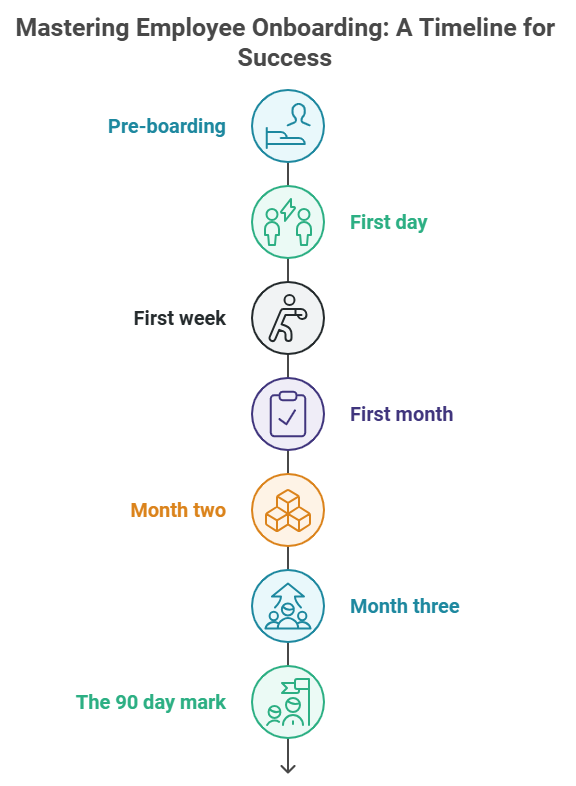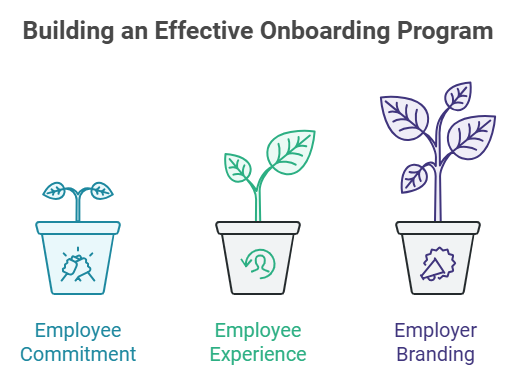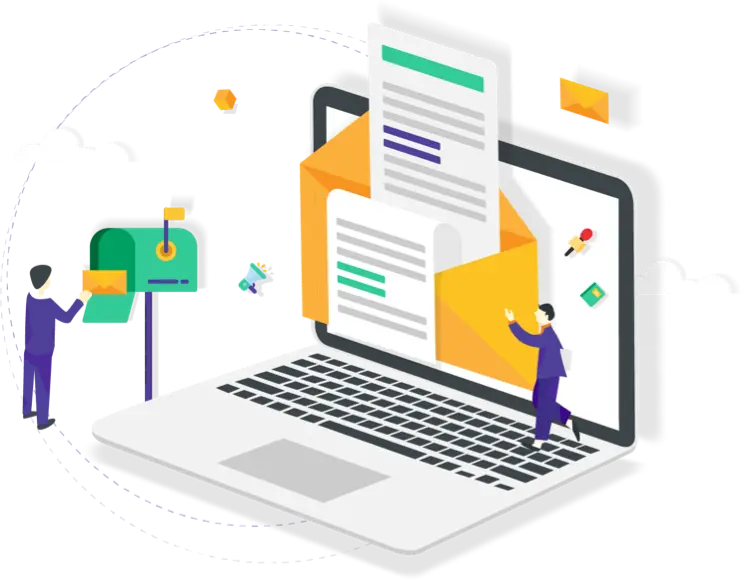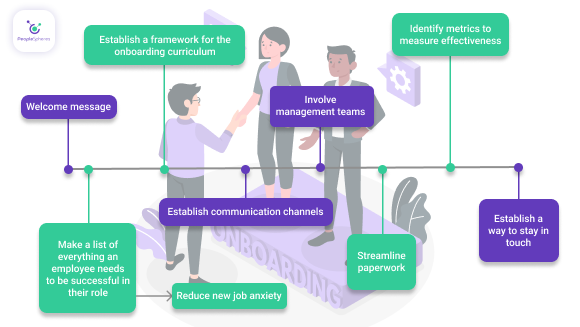
One of the most important things an organization can do for its talent acquisition is to coordinate an effective onboarding experience with the help of co-workers and supervisors.
Onboarding begins well before someone joins the organization and continues well after the first day of employment. Integrating new employees into your company involves ensuring that employees have everything they need to succeed in their role, as well as preparing training and activities to reinforce knowledge and integrate them into the team.
This article covers everything you need to know about onboarding. Learn why having an effective onboarding process is so important, and how managers and human resources (HR) can implement an effective onboarding program for employees.
Related articles:
The Ultimate Employee Onboarding Checklist
How to Create a Successful Paperless Onboarding Process
The Basics of an Onboarding Process
A user’s onboarding has been defined as:
The whole process from assimilating with the organization before they formally join, to understand the business ways of working and getting up to speed in their role
CIPD
Managers and HR must ensure that every element during the onboarding process, that is at the very beginning of the employee lifecycle, is planned and executed to perfection, to ensure every hired employee is seamlessly welcomed into the organization. By onboarding new employees properly, one can ensure that new staff are not overwhelmed by all the new hire paperwork and provide a better new hire orientation.
When it comes to talent, there is a
continued surge in demand and retaining talent in a hybrid or remote environment is more difficult
Gartner study
This would mean that the retention plan should start since the onboarding of the employee.
Onboarding Timeline
The average new hire is expected to complete 54 activities to complete the onboarding process, however, this can vary considerably from company to company. Within the HR community, it is most commonly expressed that the onboarding process lasts from three to six months. In some cases, user onboarding continues through the entire first year of employment. To optimize the onboarding process, the onboarding timeline should be divided into phases:
- Pre-boarding
- First day
- First week
- First month
- Month two
- Month three
- The 90-day mark

Onboarding Checklist
Of course, the onboarding timeline is going to be dependent on your business practices. To ensure that all your new hires will have a positive onboarding experience, it is a good idea to create an onboarding checklist. The checklist can include things such as signing an offer letter, procuring devices and equipment, preparing paperwork, setting up online accounts, and more. The checklist serves HR professionals as a framework in the onboarding process and takes off stress when integrating a new employee. If you want to learn more about what to put in your onboarding checklist, check out our ultimate employee onboarding checklist.
How an Effective Onboarding Program Can Make or Break Your Company
An effective onboarding program is easy to overlook, but it can have a major impact on an employee’s integration into the team, as well as their job satisfaction. If organizations get onboarding right, they are more likely to see increased employee retention and employee engagement, as well as improved morale, productivity, and stronger employee performance.
Increased Employee Commitment
Getting onboarding right means that from the start, your employees will be engaged and in tune with their new jobs, the company, and its goals. A recent study suggests that a quarter of employees will resign in their first ninety days; an effective onboarding program will mitigate this risk. It will likely increase the chances of the employee becoming loyal in the long term with new and existing employees.
Improved Employee Experience
An effective onboarding program is a powerful tool to enable all new employees to settle in, get to know the business, and, perhaps most importantly of all, socialize with all employees. A well-crafted induction program will introduce the employee to the workplace, its standards, and the leadership. It will give employees a chance to meet their new team and mingle with other new joiners who are in the same boat, therefore bonding over their shared experience, and would hopefully quell any fears or anxieties. Put simply, an effective onboarding program will set up newly hired employees for future success and increase organizational culture. This is something organizations are now taking more actions and letting technology take the lead with the introduction of HR systems.
Improve Employer Branding and HR Reputation
An established, structured, and effective onboarding program is very marketable. It will make the employer value proposition (EVP) tangible and credible. It can also showcase the great things an organization does to look after its people.
Onboarding programs should be developed with an organization’s image and branding strategy in mind. It should be synchronized to the EVP, demonstrating to prospective talent – as well as newcomers – what working for the organization is all about with its organizational commitment and how they manage new talent.
Finally, seeing as an effective onboarding program is so closely related to positive HR measures, such as decreased labor turnover and increased employee engagement. Creating an effective onboarding program will highlight the achievements and talents of your HR department and increase employee satisfaction. Through a better orientation, you can also get to know more of the employees such as knowledge of things not mentioned on their CV such as an interest they have. This could also affect the work environment as the employee will feel the sense that the company cares about their growth within the company. Strategies must be customizable for each employee. One must be able to ask questions and be information-seeking in every aspect of the employee’s ideal work life.

How to Create an Onboarding Program
Managers and HR must work together to create an effective onboarding experience for employees. It is a considerable team effort to increase role clarity and accelerate the integration of the newly employed. Putting together the best onboarding practices requires operational considerations such as documenting meetings, setting technical training, e-learning, paperwork, tours, and performance management documentation.
1. Welcome Message
When welcoming a new employee to your team, the first impression is everything. This is why it is crucial not to underestimate the importance of the welcome message, which can be expressed as either a welcome letter, or more commonly used, a welcome email. A proper welcome statement will give your new team member an impression of professionalism and good company culture. If you are wondering how to write a welcome message to your new employee, start with your company values. In your official welcome statement, you want your company values to shine through clearly. Express enthusiasm and appreciation to make the new hire feel valued. One of many examples of effective and professional welcome messages could be:
We are very delighted that you have come to the conclusion of joining our team. On behalf of myself and the rest of our company, we would like to extend our warmest welcome
2. Make a List of Everything an Employee Needs to be Successful in Their Role
This list should not start and end with a job description. Managers should, however, review the job description and ensure that all new hires will have everything they need to execute their duties successfully and productively during their first few weeks, as well as consider the development of soft skills and employee engagement activities. This might include information on breaks, vacation policies, and a list of contact information of people the newcomer might need to reach out to.
Reduce New Job Anxiety
A phenomenon known as new job anxiety can appear when an individual is starting a new position. New job anxiety is believed to originate from the feeling of the unknown, fear of loneliness, and imposter syndrome. There are multiple actions your HR team can take to help reduce new job anxiety for your new hire, but to start by writing a list of everything an employees needs to be successful in their role, will help reduce feelings of the unknown and imposter syndrome.
3. Establish a Framework for the Onboarding Curriculum
An effective onboarding framework not only maps out learning and supports interventions but, is also designed to be shared with the new joiner, ideally ahead of their start date. Onboarding frameworks will map out meetings and activities daily. Naturally, a lot of these will be concentrated on the first few days or weeks but will also include activities up to the end of the employee’s probation period, between the 90-day mark and or the six-month service point.
4. Establish Communication Channels
Organizations might wish to encourage new joiners to communicate even before they enjoy their first day. You can utilize your company’s preferred internal communication tool. Some companies are also setting up online communities such as Facebook groups to socialize in the run-up to day one. Whenever this is done, a critical part of onboarding is to allow the new employees to get to know each other.
The onboarding framework mentioned above will include contact information, as well as a general phone and email directory of key people, such as the employees’ team members, managers, and mentors. It is also important to establish communication norms, such as standards, etiquette, and scheduling dates for one-to-ones and job chats for new hires.
5. Involve Management Teams
A critical part of onboarding is to ensure that leadership is visible and makes specific time to meet with new joiners. This could be one-on-one, if a newcomer needs to have facetime with certain managers, and/or group meetings with executive leadership. Either way, managers of induction programs should schedule these meetings in advance and build them into the onboarding framework. Newcomers should be briefed on what (if anything) to prepare for these meetings.
Another nice touch is to set up a ‘coffee morning’ with newcomers and executive leadership a month or so into their job, so these managers can understand how the new hires are settling into the new onboarding techniques.
6. Streamline Paperwork
Utilizing effective Business Process Management (BPM) or Human Resources Information System (HRIS) software may enable some organizations to send out paperwork, such as offer letters, confidentiality agreements, handbooks, and have candidates complete them electronically, in advance of their first day, thus saving a lot of time during onboarding. In the study “The Top 5 Priorities for HR Leaders in 2023”, there was an emphasized attention to remote working and how this can be a challenge for HR professionals, and
a tool to help with this problem would be to incentivize managers’ support for mobility
Gartner Study
How organizations are tackling this problem is through the implementation of software as it provides more mobility to employees as the application will be in your fingertips. This is a great tool to implement and provide a solution to employees to facilitate the onboarding process by having all documentation in order as well.
HR should look at ways to make as much of the process as paperless as possible. To create a successful paperless onboarding process, consider including virtual learning, sending the onboarding framework via Trello, gamification, or even the use of podcasts and apps, which have the added benefit of creating a modern-feeling employer brand.
7. Identify Metrics to Measure Effectiveness
One way to measure the effectiveness of onboarding is through the ‘three Cs’ which are ‘Clarification’ – if the employee understands their job, ‘Confidence’ – measuring how effectively the employee is acquiring new skills, and ‘Connection’ – assessment of how well the employee can build effective relationships and access support. These three Cs can be assessed through regular pulse engagement surveys, and, to some extent, through productivity tools which will evaluate how quickly the employee is able to get up-to-speed in their job. Measurement of labor turnover and exit interview responses will also enable data-driven HR teams to understand how effective their onboarding programs are and what is expected from the company to positively affect the employee turnover rate.
8. Establish a Way to Stay in Touch
Effective onboarding relies on constant support and mentorship techniques. Leaders and HR professionals in charge of onboarding must ensure that newcomers have a mentor to go to for support and that there are planned follow-up meetings that are scheduled in advance and committed to by all parties. These can include weekly check-ins between the employee and their manager, probation review meetings, and coffee mornings, allowing cohorts to socialize and maybe meet with executive leadership. Establishing and sustaining an open-door policy is a critical part of this process. This will ensure an increase in the productivity of the workflow as there will be less confusion for a new hire.
Onboarding Automation Tools
One of the largest challenges to the above guidance is that HR must do all they can to ensure consistency, in that every employee gets the same onboarding experience as other employees.
Many companies are utilizing talent management application adoption with 75% is currently in use or is implementing it based on the 2021 HR Tech Survey, Sapient report. There are many reasons why to use employee onboarding tools. First, by offering a paperless onboarding process which can be completed in advance of an employee joining, HR teams could also track learning progress through e-learning tools, as well as onboarding checklists linked to the organization’s HRIS and probation system. Automated feedback systems can measure in real-time new joiner satisfaction. Finally, even supporting elements of onboarding can be automated, such as knowledge checks conducted, and employees being automatically enrolled into benefit websites.
Conclusion
An effective new onboarding process will have a critical part of the employee experience and the overall employee life cycle. It can significantly contribute to a well-run and high-performing workforce. Nevertheless, creating an effective onboarding program is not easy and there are many elements to draw together.
If you are still feeling confused about the onboarding process or want even more tips on how to facilitate it, we have an in-depth article on ways to optimize your employee integration process.







